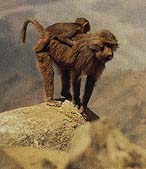Picture by Hagen Schmid
 There is no doubt that Jane Goodall and Dianne Fossey, both immortalized
in beautifully photographed National Geographic articles, revolutionized
primate research in the wild and introduced the uninitiated to
the delights and thrills of field work with chimpanzees and gorillas.
There is, however, another dimension to the story of primate behaviour
which has been powerfully documented by Hans Kummer in his fascinating
book In Quest of the Sacred Baboon, subtitled A Scientist's Journey.
A journey in both the physical and spiritual sense, it commences
with a small population of hamadryas baboons, a semi-desert dweller
which the ancient Egyptians believed to be the incarnation of
the god Thoth, resident in Zurich Zoo and takes us across the
deserts of Ethiopia to the sparse Asir Mountains in the Kingdom
of Saudi Arabia.
There is no doubt that Jane Goodall and Dianne Fossey, both immortalized
in beautifully photographed National Geographic articles, revolutionized
primate research in the wild and introduced the uninitiated to
the delights and thrills of field work with chimpanzees and gorillas.
There is, however, another dimension to the story of primate behaviour
which has been powerfully documented by Hans Kummer in his fascinating
book In Quest of the Sacred Baboon, subtitled A Scientist's Journey.
A journey in both the physical and spiritual sense, it commences
with a small population of hamadryas baboons, a semi-desert dweller
which the ancient Egyptians believed to be the incarnation of
the god Thoth, resident in Zurich Zoo and takes us across the
deserts of Ethiopia to the sparse Asir Mountains in the Kingdom
of Saudi Arabia.
Hans Kummer not only re-creates the adventure and intellectual thrill of the early days of field research on primates, he also writes with great perception and sensitivity about the people and places he visited and his own personal growth. Although at all times scientifically accurate as he describes in detail the social structure of the hamadryas baboon, Kummer deliberately eschews the arid language of scientific journals to paint a truly vivid picture of the pioneering work of Project Hamadryas.
Although much of the work was accomplished in the Danakil Desert in Ethiopia, Kummer notes that there are no obvious differences in external form between the Arabian and the Ethiopian hamadryas baboons. Furthermore, he says the behaviour of the animals to the west of the Red Sea and east of the Red Sea differed only with respect to a very few gestures. 'Behavioral comparison gives preliminary evidence that the separation between the east and west coast populations occurred only a few thousand years ago', he comments.
Hamadryas baboons are considered to have one of the most highly structured social systems among primates, very close, in some respects, to that of humans. Kummer notes: 'It lives in a patriarchal community in which the male has evolved both of the fundamental aspects of fighting: a sharp canine tooth and a network of alliances. This finding was a surprise to us. In most related primate species the network of alliances is the specialty of females.'The fascinating thing about the patriarchal hamadryas males is that they have managed to integrate permanent female 'relationships' into a cooperative male society, despite intense competition for females. This social structure is apparently found in only two other primate species: the gelada baboon of the high mountains in Ethiopia, and the human.
Kummer stresses the necessity for dialogue with nature for successful field research. He points out that when the study animal seems to conform to all the researchers hypotheses then it is unlikely dialogue has been attained. Sympathetic portraits of many students of animal behaviour are to be found in the pages of the book, however it is the unschooled bedouin boy Mahdi from Wadi Ranyah in Saudi Arabia who receives the most praise for his innate scientific abilities: 'I was moved by my little colleague. What he said bore the stamp of accurate personal observation. Still more convincing were his imitations, because there could be no mistake in translation. What the male "says" to his fallible female was preceded by the cautious formulation "as though," a turn of phrase that elegantly separates interpretation from observation - the primary virtue of the scientist.'
Project Hamadryas was effectively ended by the war in Ogaden in 1977, however hamadryas baboon research in the field has continued in Saudi Arabia. The work of Saudi biologist Ahmed Bourg and French primatologists, Sylvain Biquand and Veronique Biquand-Guyot is given particular mention in Kummer's book.
In Quest of the Sacred Baboon, has something for everyone - scientist, naturalist, armchair traveller, and student of human nature.
Web Links | Subjects | Search
Arabian Wildlife. Volume 3, Number 1